We analyzed U.S. jobs data from over 10,000 companies between 2019 and 2021 looking for recruiting trends. We made some surprising discoveries about who’s hiring and where, how companies are reacting to the tech labor shortage, where the industry stands on the employment gender gap, and more.
If you’re curious what other companies are doing now and which recruiting trends you should follow, this report may help. Here are the highlights:
Post-pandemic recruiting trends
- Open tech jobs received a median of 120 applicants in 2019 but only 77 in 2021!
- There were 81% more tech jobs advertised in 2021 than in pre-pandemic 2019.
- Only about 25% of tech job applicants are female.
- The employment gender gap grows wider as the seniority of a tech job rises.
- 80%+ of all applicants to tech jobs come from organic sources (e.g., company career sites, LinkedIn, and online job boards).
- Yet applicants from referral programs are 9x to 18x times more likely to get hired than applicants from organic sources.
- Meanwhile, 85% of female applicants to tech jobs apply using organic sources.
- Remote hiring is exploding (e.g., up 300% at Fortune 500 companies) and changing job requirements (e.g., 221% increase in requirements for remote team management).
- Smaller companies are driving most of the tech job growth, not Fortune 500 or public companies.
- Tech job growth is higher in emerging tech hubs like Miami and Salt Lake City than it is in traditional powerhouses like Seattle and the San Francisco Bay Area.
- In 2021, 25% more tech jobs did not require a degree compared to 2019.
- But while degree requirements are down, requirements for cloud certifications are up.
- Companies are turning to title inflation (e.g., adding ‘Senior’ to a mid-level job) during the tech labor shortage.
- Soft skills and generic job requirements are decreasing, although corporate cliches and jargon are still everywhere.
- Amazon hires way more than any other tech company, and they do so in their own way (i.e., bucking some current recruiting trends).
How this tech jobs report on recruiting trends is unique
First, we collected job listing data directly from over 10,000 companies and analyzed them for trends. We’re the only ones with access to our data, so this report is unique.
Second, we use our own internal research and language models to deconstruct and categorize the data. Most of the market reports you read are based on government data. They use job titles (which can be deceiving) and basic company information as the basis for their analyses.
We go much deeper than that. We annotate job outcomes data by job type, company, applicant, and application sources. Our language models enable us to deconstruct each job description by language attributes, job type, skills, and qualifications. And we look at job location and multiple employer attributes, not just company name.
All of that is to say that this report goes much deeper than the occupational and industry classifications available in government data. It’s how we’re able to identify certain recruiting trends in the tech industry. For example, not only how requirements are changing but how they’re changing for specific job types, company types, and even locations.
Okay, to the results!
1. The tech labor shortage is real
There’s a good reason why it’s harder to find applicants for tech jobs these days. There are simply fewer of them in the pipeline. Open tech jobs received a median of 120 applicants in 2019 but only 77 in 2021. The tech labor shortage is real.
And it’s real because companies have received huge funding rounds and valuations. They’ve gotten funding for bigger workforces, and they’ve been advertising for more open jobs. Meanwhile, attrition has hit new highs as a result of the Great Resignation (which wasn’t just unhappy employees switching jobs). The combination has created a very competitive job market in a very short amount of time.
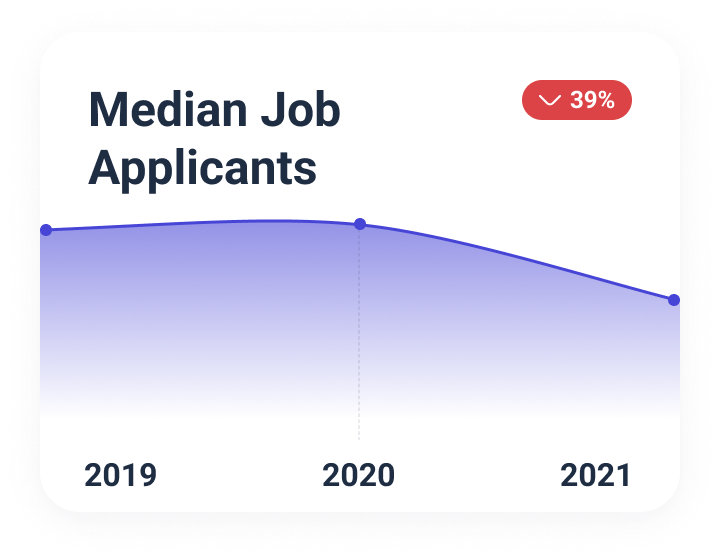
2. Tech job growth hasn’t slowed down
Despite a little slowdown in 2020, tech job growth hasn’t really missed a beat. At the start of the pandemic, hiring stalled in tech like it did in every other industry. But it rebounded strongly. In fact, fundraising and equity markets were soon at all-time highs.
Companies advertised 81% more open tech jobs in 2021 than they did in pre-pandemic 2019. Somehow in the midst of high unemployment elsewhere, tech job growth continued. Companies kept advertising for new jobs, further tightening the competitive job market.
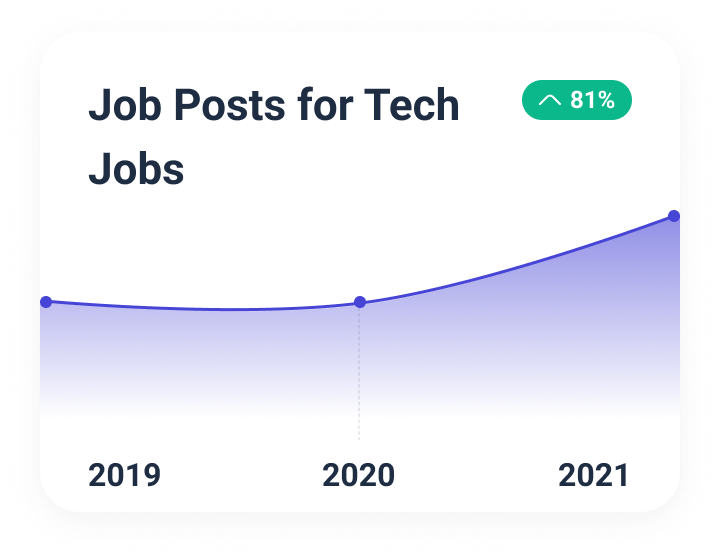
3. Female representation is still low in tech applicant pools
Applicant pools for tech jobs are still primarily male, despite recent work by the industry to improve female representation. This trend is true across most job types, although a few factors (including job seniority level) have more or less impact on female representation.
Overall, men make up 67% of all tech job applicants. They make up 65% of applicants for junior tech jobs (usually four years of experience or less), and 72% of applicants for senior tech jobs (at least 10 years of experience). (If that seniority figure catches your eye – it caught ours – more on it below.)
Women make up less than 20% of engineering teams and less than 25% of computer engineering teams. Part of that is because companies hire a lot of candidates with degrees in computer science, and female representation in those programs is low.
According to a Pew Research Center report, although “women now earn a majority of all undergraduate and advanced degrees, they remain a small share of degree earners in fields like engineering and computer science – areas where they are significantly underrepresented in the workforce.”
Areas where female representation is higher include quality assurance (QA), enterprise resource planning (ERP), and user interface/user experience (UI/UX) design. (Note: We don’t have gender information on about 8% of the applicants in our data.)
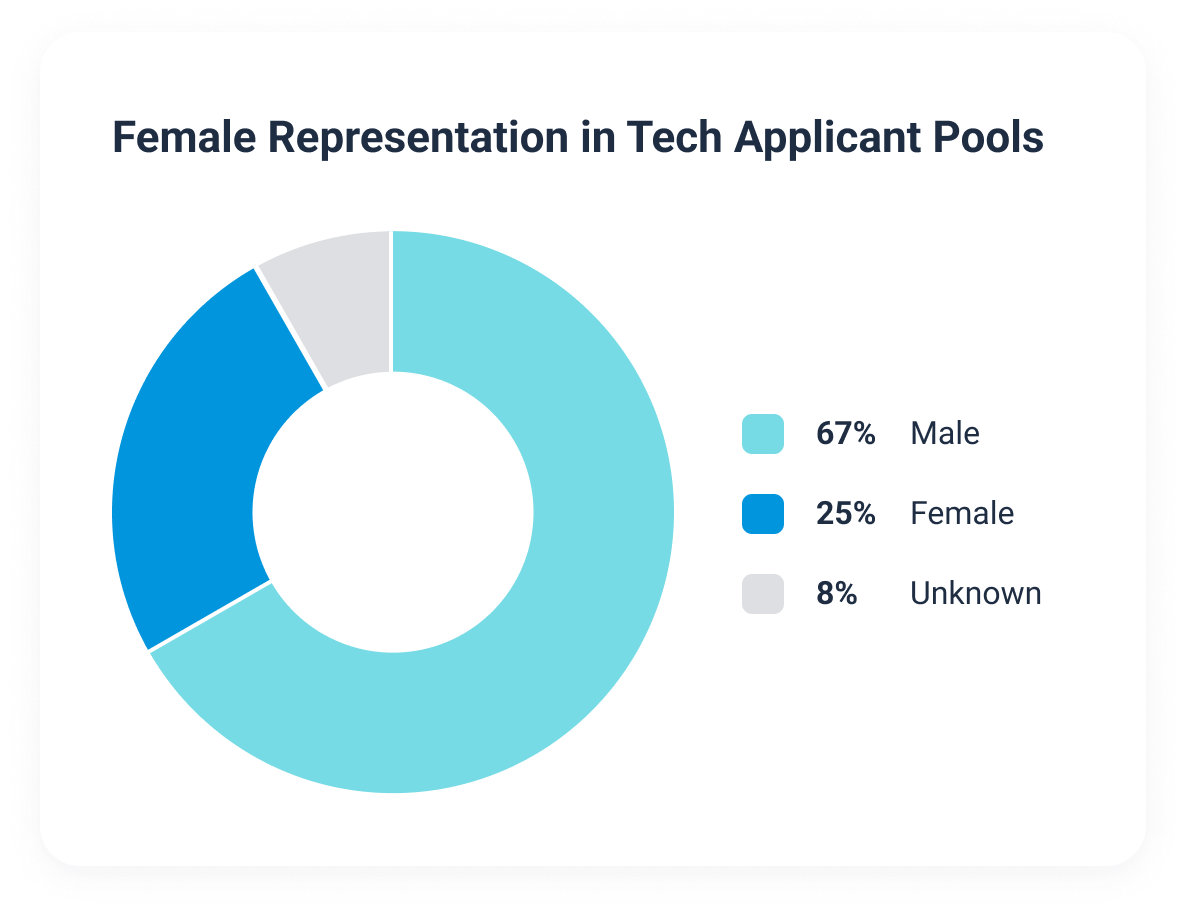
4. The employment gender gap actually widens as the seniority level of a job rises
About that seniority level stat above, you read it correctly. When we filter jobs by seniority level, we find that female representation (already low in tech hiring) drops even more as seniority level goes up.
Senior-level jobs tend to have smaller applicant pools in general than junior and mid-level jobs, according to our data. That isn’t a huge surprise. The surprise is that there’s less female representation in mid-level jobs than in junior jobs, and even less in senior jobs. In other words, the employment gender gap gets wider as seniority level rises.
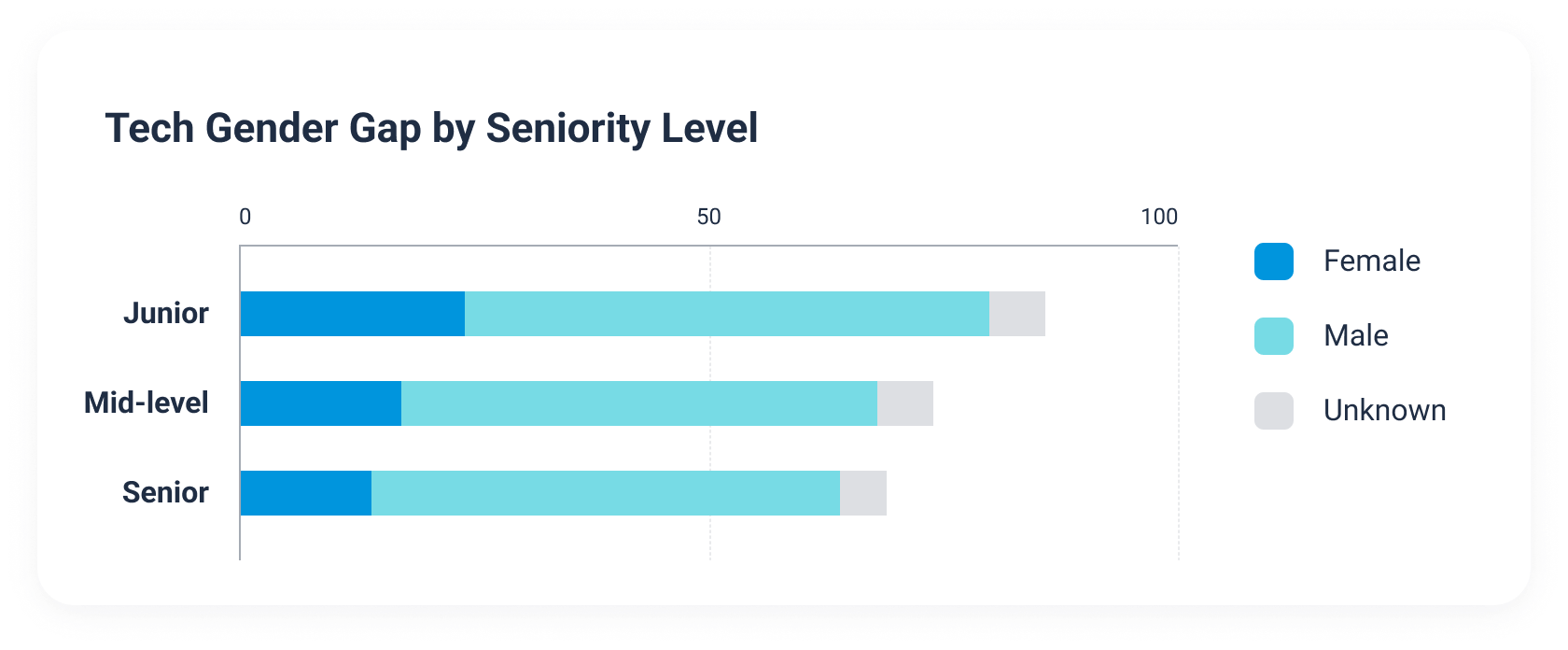
5. Organic sources accounted for most tech job applicants
Any number of tactics exist to attract job applicants, and hiring teams tend to use whichever ones work. However, not all candidate sourcing methods are fair to job seekers, and sourcing method can determine which applicants hiring teams find.
Organic sources are open to anyone with a resume and internet access. They include online job boards, LinkedIn, and company career sites. Inorganic sources are only open to certain job seekers. They include referral programs, prospecting lists, third-party sourcers, and the like.
Organic sources are more equitable because they invite everyone, while inorganic sources are less equitable because they only give certain job seekers access (e.g., they know someone at the company for a referral).
Most applicants come from organic sources – 86% of them, actually. The majority of those applicants come from company career pages and LinkedIn. The LinkedIn stat is noteworthy given the proliferation of tech hiring platforms in recent years (e.g., Hired, TripleByte) that have yet to supplant organic sources like LinkedIn.
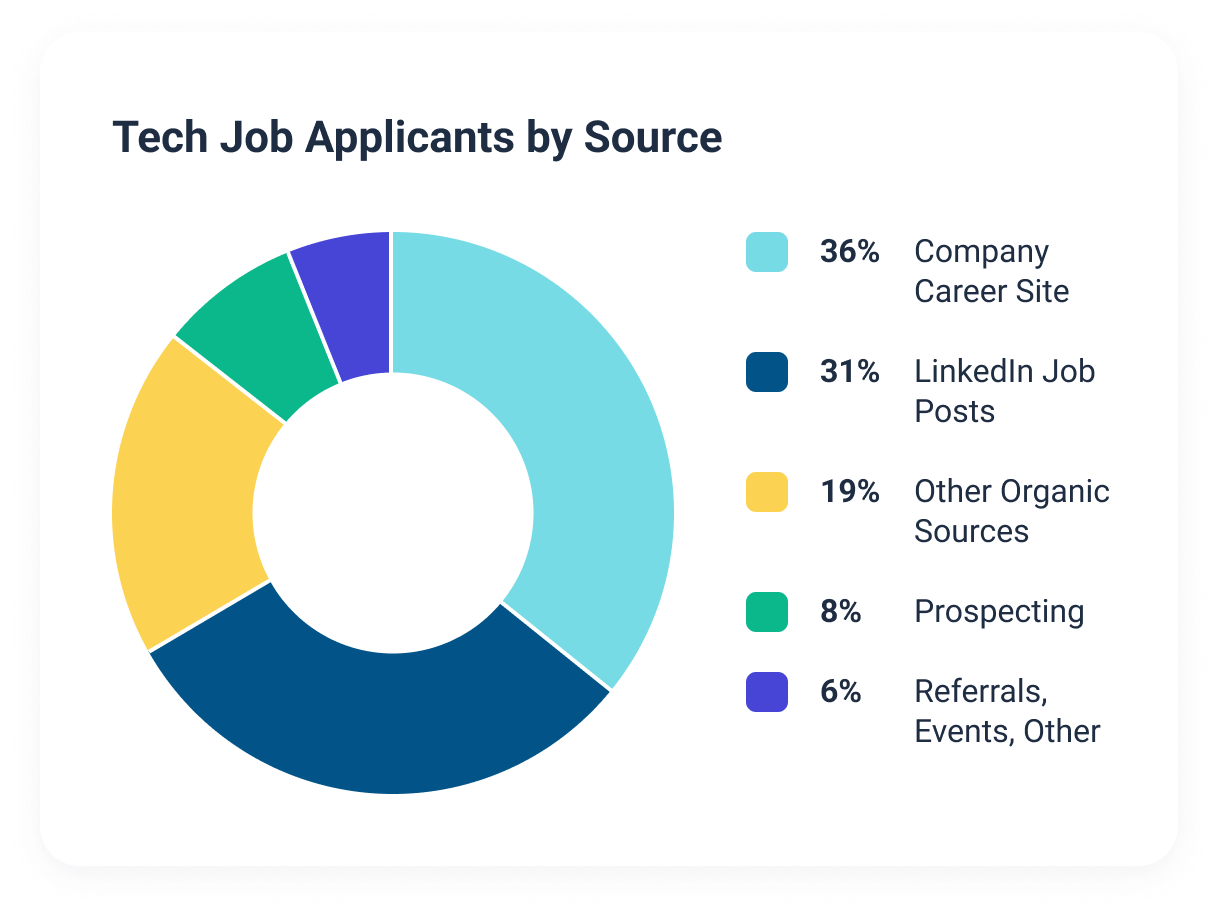
6. Applicants from referrals are 9x to 18x more likely to get hired than applicants from organic sources
While hiring teams use both organic and inorganic sources to find applicants, they don’t necessarily hire from those groups proportionately. In fact, our data show a heavy bias towards candidates from inorganic sources.
Organic applicants represent over 80% of all applicants, yet they represent only about half of all hires. Applicants from referral programs are 9 times more likely to get hired than applicants from company career sites and 18 times more likely than applicants from LinkedIn.
Organic sources cast as wide a net as possible to reach the most applicants, while inorganic sources target certain job seekers. The problem is that inorganic approaches exclude large swaths of qualified job seekers outside of these networks. They also risk exacerbating inequities and getting in the way of companies’ diversity, equity, and inclusion (DEI) efforts. (Even in a competitive job market, DEI still matters to many companies, as it should.)
For our analysis, we used a representation ratio to establish bias towards or against certain candidate sources. A value of 1 suggests the number of hires is proportionate to the number of applicants. Meanwhile, a value of less than 1 suggests bias against that source. And a value of more than 1 suggests bias for that source.

7. Most female applicants apply using organic sources
Meanwhile, the vast majority of female applicants comes from organic sources. A full 85% of all female applicants to tech jobs applied either on the company career site (36%), LinkedIn (32%), Indeed (11%), or some other organic source (7%).
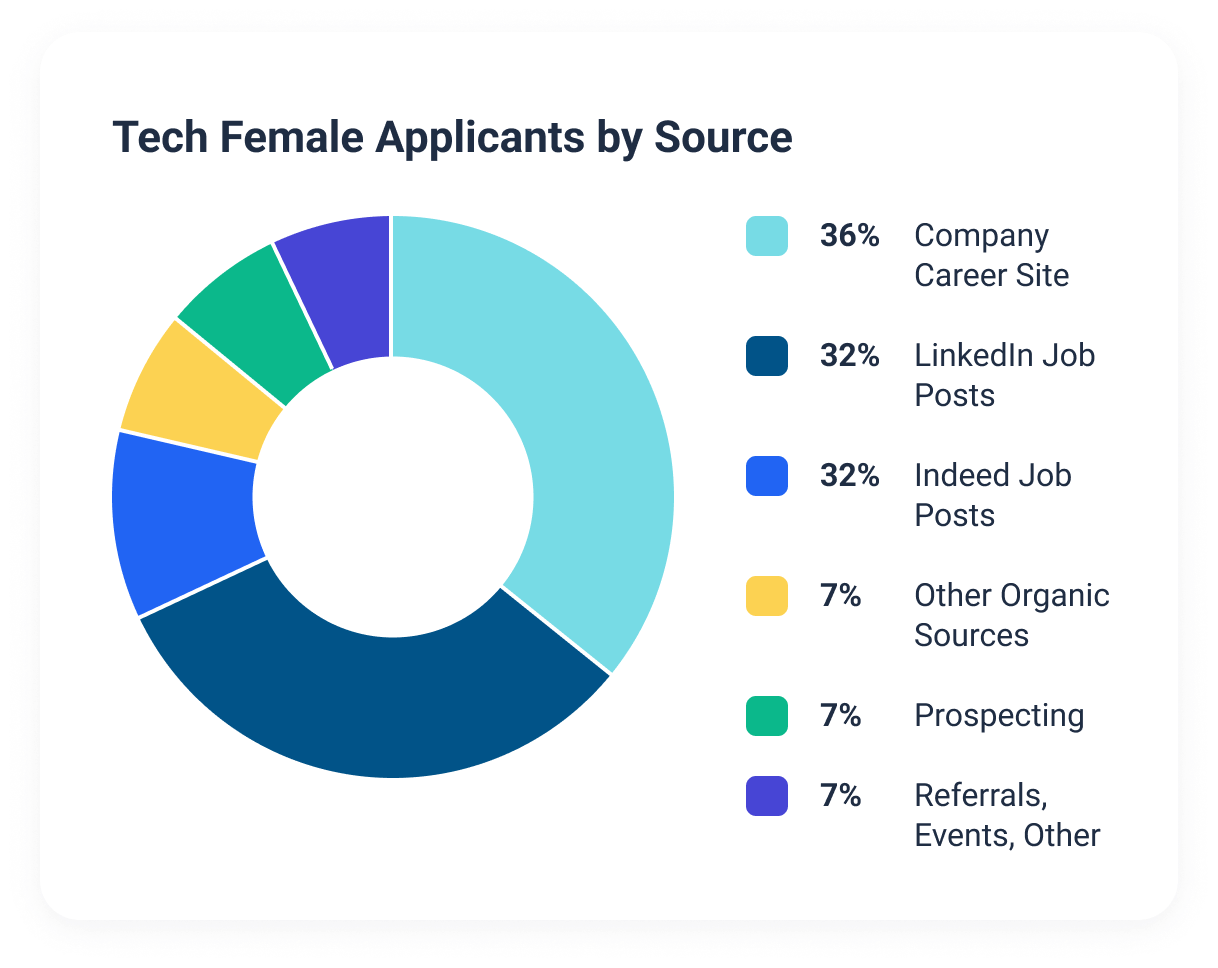
Adding seniority into the mix didn’t change female representation. Organic sources are the primary source of female applicants regardless of the seniority level of the job.
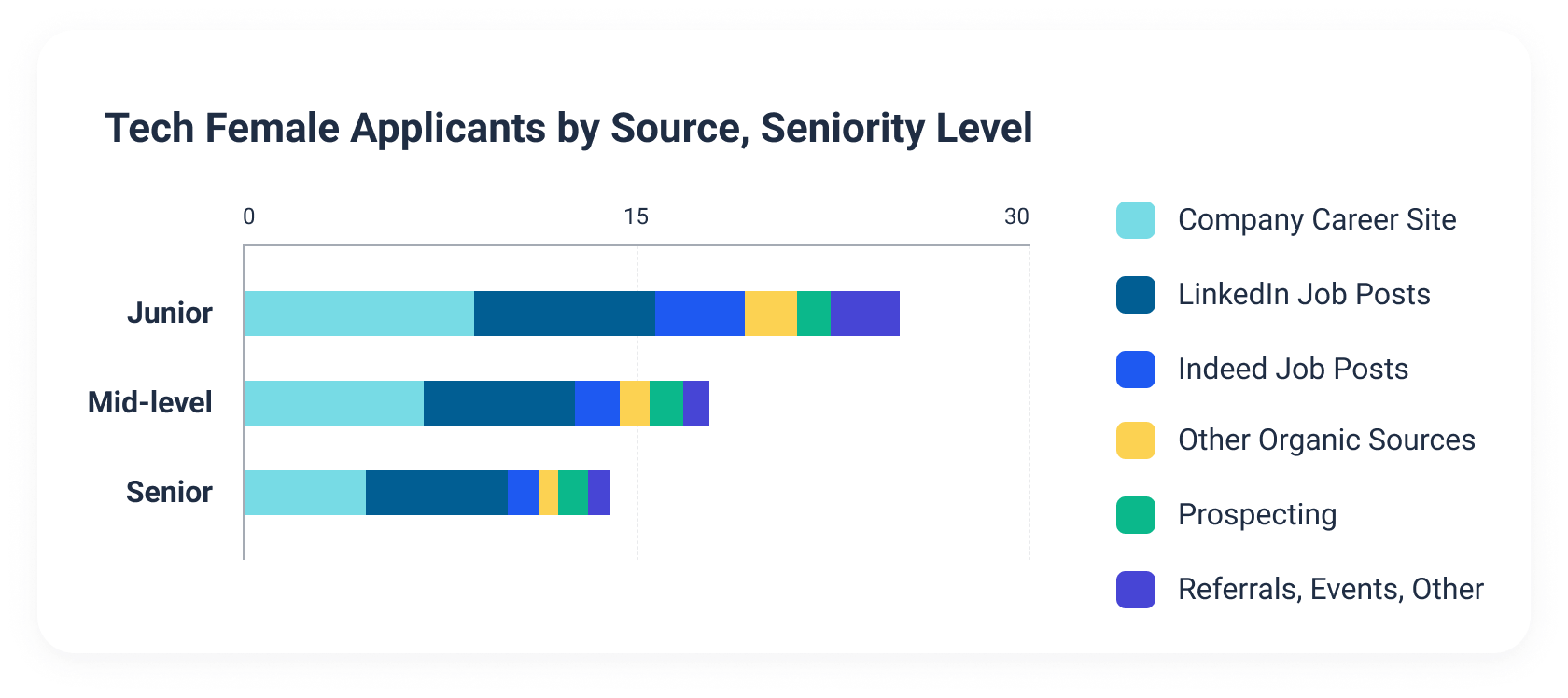
8. Remote hiring is booming and changing job requirements
Our data shows that remote hiring has increased dramatically, especially at companies that previously dragged their feet on the issue. Our data also shows that remote hiring has had an impact on job requirements.
Historically, startups and unicorns were the biggest sources of remote jobs, and remote hiring has continued to grow rapidly at those companies. But now companies that were not previously remote are getting in on it too. Fortune 500 and public companies, despite investing in sprawling campuses, have seen a nearly 300% increase in remote jobs.
With this growth in remote hiring has come a change in job requirements. Demand for experience managing remote teams is up 221%, while experience collaborating in remote teams is up 67%.
9. Smaller companies account for most of the tech job growth
Most of the tech job growth is coming from smaller companies, not Fortune 500 companies. It’s coming from startups (private companies back by funding, often venture), unicorns (private companies with a $1 billion valuation), and smaller public companies.
This goes back to the recent explosion of fundraising and equity markets in the tech industry. After the initial downturn during the pandemic, tech hiring turned away from traditional companies in favor of newer arrivals. That’s not to say that hiring for tech jobs hasn’t grown at traditional companies ─ it has. It has just grown faster at startups, unicorns, and smaller public companies.
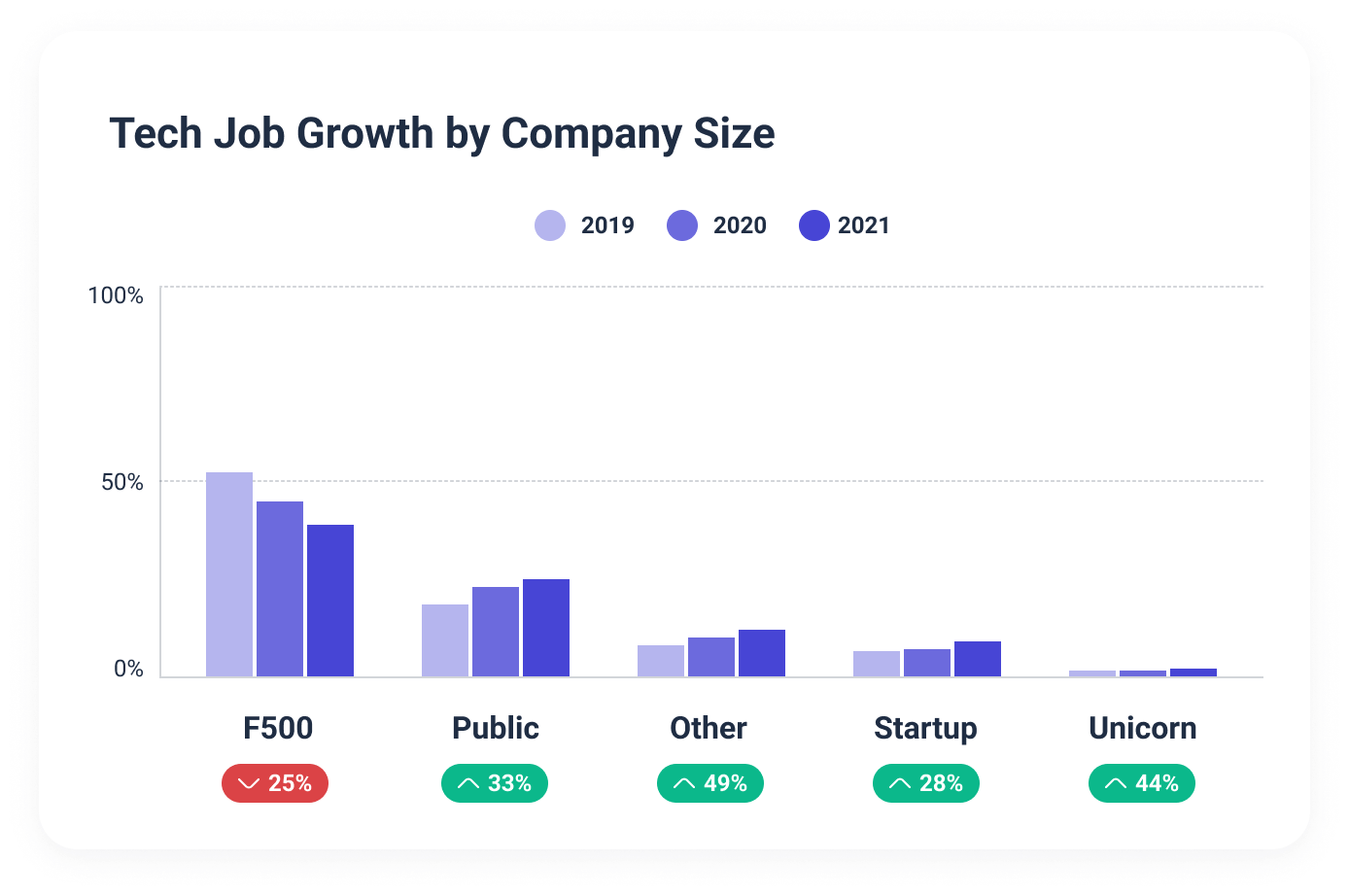
10. Tech job growth is happening faster in emerging tech hubs
While hiring has shifted away from traditional companies, it has also shifted away from traditional markets. Tech job growth is happening faster in emerging tech hubs than it is in traditional tech powerhouses. (Remote job growth is a factor, but not the only one.)
Seattle and the San Francisco Bay Area’s slice of the tech jobs pie, for example, is 25% smaller post-pandemic than it was pre-pandemic. Emerging tech hubs like Miami, Salt Lake City, Austin, Atlanta, and Detroit have cut into their share. (Validating the moves of certain venture capitalists to emerging tech hubs, such as Keith Rabois’ move to Miami.)
The map below illustrates these cities’ job growth as a proportion of all tech jobs in the U.S. (i.e., how much their share of the pie grew).
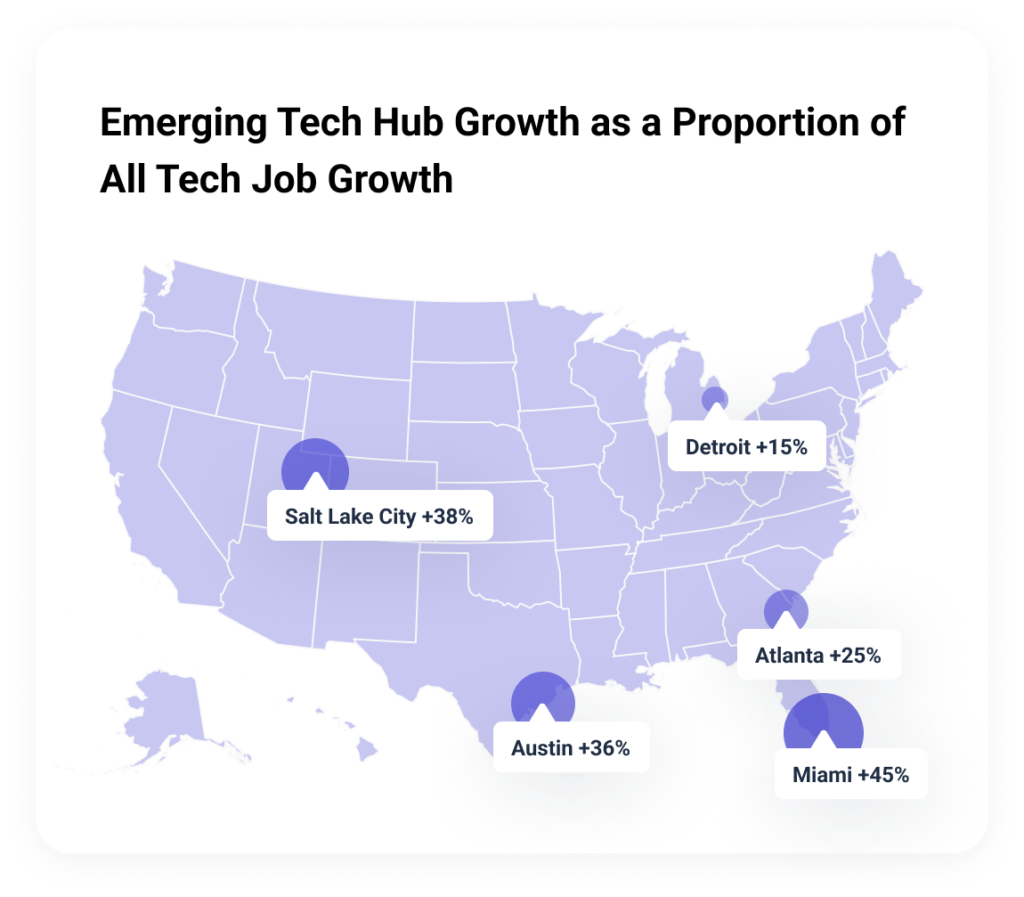
11. Degree requirements are down during the labor shortage
Companies are rethinking degree requirements, and the tight labor market is accelerating the trend. The proportion of jobs in the tech industry that don’t require a college degree is up 25% from 2019. Of the 16 tech job types we used for this report, 12 of them have seen an increase.
Our data shows that education requirements are falling across all job types. Requests for Master’s degrees are down 35%, and requests for MBAs are down 17%. The only outlier is a 25% increase in Master’s degree requirements among the FAANG companies (Facebook [Meta], Amazon, Apple, Netflix, and Google [Alphabet]).
One of the most interesting recruiting trends we’re seeing is fewer jobs requiring Bachelor’s degrees, even though companies are advertising for fewer entry-level jobs. Fewer entry-level jobs and more mid-level jobs should mean more education requirements (i.e., you would expect a mid-level position to include education requirements, not necessarily an entry-level one). Yet the opposite is true.
(It’s not a bad thing considering that only about 1 in 3 job seekers in the U.S. had a Bachelor’s degree in 2019, according to an American Community Survey report.)
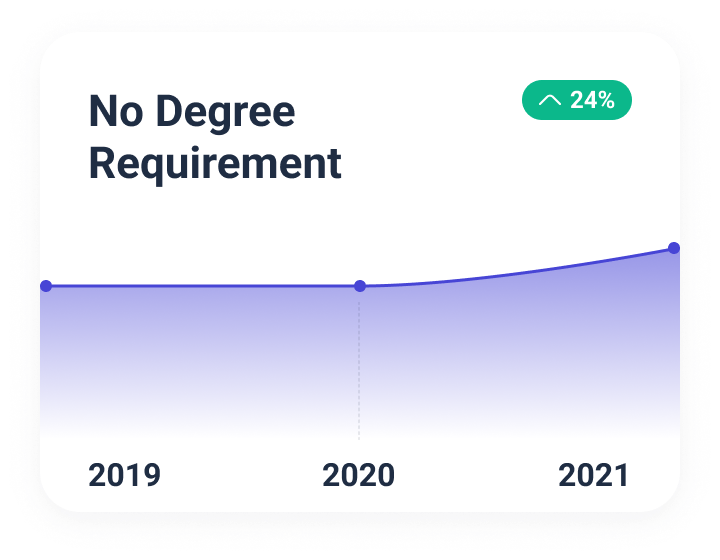
12. Requirements for cloud certifications are on the rise
Along with a drop in degree requirements during the labor shortage, we’re also seeing a drop in professional certification requirements overall. With the notable exception of cloud certifications.
For our purposes, we’re ignoring requirements that reference ‘proficiency in’ or ‘experience with’ a cloud provider. Instead, we’re focusing on jobs that ask for formal cloud certifications like those offered for Amazon Web Services (AWS), Google Cloud, or Microsoft Azure. Requests for those cloud certifications have risen sharply. We believe the increases reflect how employers perceive certain technologies (i.e., their utility and importance, now and in the future).



13. Companies are turning to title inflation during the labor shortage
Companies tend to adapt their hiring practices during a labor shortage, and we’re seeing that in our data. Title inflation occurs when hiring teams choose a title that seems more senior than the job requirements imply. Recruiters are turning to title inflation to make jobs more attractive to candidates.
About 25% of jobs that in 2019 were considered junior (less than 4 years of experience) now carry senior titles (10+ years of experience). At the same time, the number of junior jobs that include the word ‘Lead’ has doubled since 2019. The word ‘Senior’ is 20% more prevalent in mid-level jobs today, and the word ‘Staff’ is 25% more prevalent (e.g., ‘Staff Engineer’).
The main problem with title inflation is that job titles serve a different purpose in recruiting than they do in human resources (HR). Internally, titles may act as a leveling mechanism for HR. Externally, they act as keywords in internet job board searches and a way for job seekers to determine whether they qualify. (For example, adding ‘Senior’ to a job title can deter a qualified job seeker even when they match the job’s requirements.)


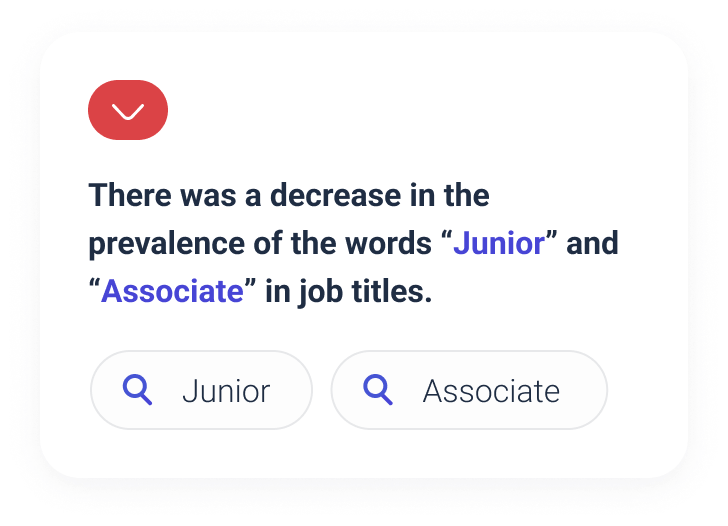
14. While soft skills are down in job descriptions, corporate cliches still abound
Basically, soft skills are non-specific, intangible attributes like ‘communication skills’ and ‘work ethic.’ They’re distinct from hard skills, which are absolutely necessary to perform a job (e.g., expertise in the Python programming language for a Python Developer).
Meanwhile, cliches are jargon, buzzwords, and other tired phrases that don’t mean what they once did (e.g., ‘think outside the box’ or ‘drive business growth’).
Soft skills
Soft skills often find their way into job descriptions when hiring teams run out of things to say or struggle to define concrete responsibilities and requirements. Also, more hiring teams now believe that soft skills can help identify great long-term employees, so they feel obligated to include them.
Regardless, soft skills don’t tell job seekers much about the role because they’re so generic. Yet they can make job posts longer, confuse applicants, and deter qualified job seekers. (For example, ‘ability to thrive in a competitive environment’ doesn’t help candidates self-select in or out of the applicant process. In fact, it may deter qualified candidates who think this requirement signals ‘we don’t work well together.’)
Our data shows a decline in the number of job posts that include soft skills. In 2019, about 25% of tech job posts included high levels of soft skills. That percentage was about 11% in 2020 and 2021.
This is significant considering the rising belief that soft skills help determine great long-term employees. The data suggests companies are realizing they can attract more technically qualified candidates with a wide top of funnel, then they can assess soft skills during the interview process.
Corporate Cliches
Corporate jargon, on the other hand, is still pretty much everywhere. While soft skills have gone down, corporate cliches and business jargon have seen significant growth among certain types of roles. These include jobs at the intersection of business and engineering logic like those in sales engineering, product management, and data. Meanwhile, we’re also seeing references to complete technology stacks (tech stacks) for jobs where tech stack knowledge isn’t vital or even relevant.
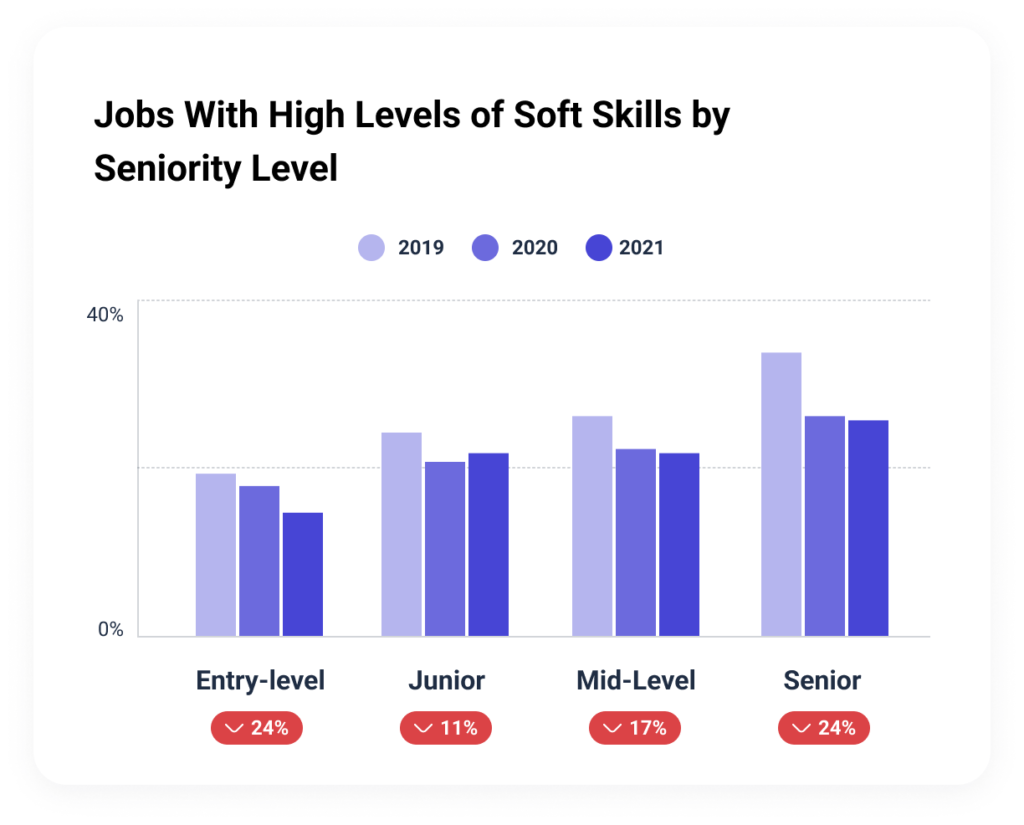
15. Amazon hires way more than any other tech company and bucks recruiting trends, even during a labor shortage
Amazon is obviously a behemoth in the tech industry. But it turns out they hire way more than anyone else. The company’s 50,000 tech hires per year is multiples of any other company in the space, even the other tech giants.
Interestingly, however, Amazon bucks a number of recent recruiting trends, despite the labor shortage. Instead of asking for fewer education and advanced degree requirements in job descriptions, the company is asking for more. As remote jobs are booming, Amazon is leaning into non-remote jobs. And the company is eschewing emerging tech hubs and hiring more in traditional tech hubs like New York City and Los Angeles.
Recruiting trends in the post-pandemic tech industry
Applicant pools for tech jobs are smaller during the labor shortage, female representation in tech hiring is still low, and the employment gender gap gets wider as seniority level rises. These are just a few of the many recruiting trends impacting tech hiring in the post-pandemic era.
And this article is just the highlights of a much larger report. If you’re interested in learning more about these and other recruiting trends in the tech industry, we invite you to read our full Tech Hiring Report.
